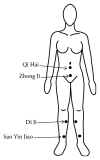Efficacy of Acupuncture versus Combined Oral Contraceptive Pill in Treatment of Moderate-to-Severe Dysmenorrhea: A Randomized Controlled Trial
- PMID: 26346199
- PMCID: PMC4539461
- DOI: 10.1155/2015/735690
Efficacy of Acupuncture versus Combined Oral Contraceptive Pill in Treatment of Moderate-to-Severe Dysmenorrhea: A Randomized Controlled Trial
Abstract
This open-label randomized controlled trial was designed to compare the efficacy of acupuncture and combined oral contraceptive (COC) pill in treating moderate-to-severe primary dysmenorrhea. Fifty-two participants were randomly assigned to receive either acupuncture (n = 27) or COC (n = 25) for three menstrual cycles. Mefenamic acid was prescribed as a recue analgesic drug with both groups. The statistical approach used for efficacy and safety assessments was intention-to-treat analysis. By the end of the study, both treatments had resulted in significant improvement over baselines in all outcomes, that is, maximal dysmenorrhea pain scores, days suffering from dysmenorrhea, amount of rescue analgesic used, and quality of life assessed by SF-36 questionnaire. Over the three treatment cycles, COC caused greater reduction in maximal pain scores than acupuncture, while improvements in the remaining outcomes were comparable. Responders were defined as participants whose maximal dysmenorrhea pain scores decreased at least 33% below their baseline. Response rates following both interventions at the end of the study were not statistically different. Acupuncture commonly caused minimal local side effects but did not cause any hormone-related side effects as did COC. In conclusion, acupuncture is an alternative option for relieving dysmenorrhea, especially when COC is not a favorable choice.
Figures



References
-
- Chongpensuklert Y., Kaewrudee S., Soontrapa S., Sakondhavut C. Dysmenorrhea in Thai secondary school students. Thai Journal of Obstetric and Gynecology. 2008;16:47–53.
-
- Singh A., Kiran D., Singh H., Nel B., Singh P., Tiwari P. Revalence and severity of dysmenorrhea: a problem related to menstruation, among first and second year female medical students. Indian Journal of Physiology and Pharmacology. 2008;52(4):389–397. - PubMed
LinkOut - more resources
Full Text Sources
Other Literature Sources

